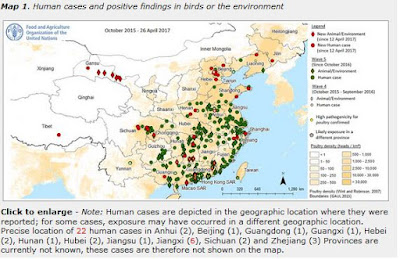 |
| Credit FAO |
#12,411
Like many other agencies, the FAO is expending a lot of resources to monitor and analyze China's H7N9 epidemic - and while their focus is primarily on how this avian virus affects the world's food and agriculture - they keep a pretty good watch on human cases as well.
One of the recent trends - easily discernible on the their map (see below) - has been an increase in the number of H7N9 positive human, bird, and environmental samples coming the northern part of china, particularly in and around Beijing and in Gansu Province (see Monday's report Jilin Province Reports 1st H7N9 Case Of 2017).I've only included some excerpts from a much larger report. Information added or changed since the last H7N9 situation update (Apr 12th) appears in red.
H7N9 situation update
26 April 2017, 17:00 hours; Rome
The next update will be issued on 3 May 2017
Overview
Situation: Influenza A(H7N9) virus with pandemic potential.
Country: China; three human cases originated in China and were reported in Malaysia (1) and Canada (2).
Number of human cases: 1444 confirmed; 545 deaths (since February 2013).
Number of new findings in birds or the environment since last update (12 April 2017): 66.
Number of new human cases since last update (12 April 2017): 47.
Provinces/municipalities: Beijing, Chongqing, Shanghai and Tianjin Municipalities; Anhui, Fujian, Gansu, Guangdong, Guizhou, Hebei, Henan, Hubei, Hunan, Jiangsu, Jiangxi, Jilin, Liaoning, Qinghai, Shandong, Sichuan, Taiwan, Yunnan and Zhejiang Provinces; Hong Kong SAR; Macao SAR, Guangxi, Ningxia Hui, Tibet and Xinjiang Uyghur Autonomous Regions; Sabah (Malaysia); British Columbia (Canada).
Animal/environmental findings: around 2,500 virological samples from the environment, chickens, pigeons, ducks and a tree sparrow tested positive; positives mainly from live bird markets, vendors and some commercial or breeding farms.
Highly pathogenic virus findings: Out of the 1444 confirmed human cases, H7N9 virus isolates from three cases (two from Guangdong and one from Taiwan Provinces) were found to be highly pathogenic for chickens. The H7N9 highly pathogenic avian influenza virus was detected in a total of 41 poultry or environmental samples (30 chickens, 1 duck and 10 environmental samples) from 23 live bird markets (LBMs) in: Fujian (Longyan City), Guangdong (Dongguan, Guangzhou, Huizhou, Lufeng, Meijiang, Meizhou, Zhongshan Cities and Haifeng County), Guangxi (Guilin City) and Hunan (Chenzhou City) Provinces; and from 3 farms in: Guangxi (Guilin City) and Hunan (backyard in Chenzhou City and a large farm in Yongzhou City [reference]) Provinces.
FAO actions: liaise with China and partners, monitor situation, monitor virus evolution, conduct market chain analysis, risk assessment, surveillance guidance and communication.
(Continue . . . )
